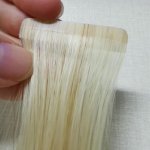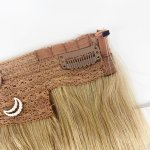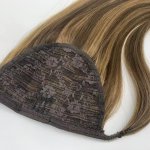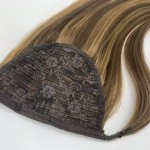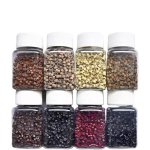Why Do Hair Extensions Turn Orange/Brassy?
With the arrival of summer, do you often receive complaints from customers, many of which are about hair discoloration or fading? Are you confused or helpless about these issues? Taking care of hair extensions is not an easy task if people are unaware of the main problems than can and do often occur. We want to explain some of these potential problems as well as present the most direct and simple solutions so that your clients can have a strong hair extension care routine.
It’s important to teach your clients how to adjust their hair care routine to keep hair extensions maintaining high quality level.
What are the main threats to hair extensions then?
1. Exposure to the sun
2. Sun screen products
3. Various kinds of hard water
4. Mineral deposits
5. How to repair discolored hair and care tips
Let’s describe these potential threats in turn and the top ways of dealing with them.
Exposure to the sun
As you might guess, UV radiation from sunlight is a fairly direct cause of damage, so it is important to limit the hair extension’s exposure to it. The sun can strip pigments from extensions, exposing the original undertones and causing dryness, frizziness, and tangling. Hair needs protection during the hot summer months, just like skin.
We highly recommend wearing some kind of hat to avoid the impact of UV radiation.
Sunscreen
Many people might not realize that the sunscreen we use daily is one of the biggest threats causing hair discoloration. Certain sunscreen contain things like Avobenzone (Butyl Methoxydibenzoylmethane) and Octocrylene can react with hair dye, causing extensions to turn peachy pink or orange.
Here are some tips for using sunscreen.
1. Using a leave-in condition with UV protection
2. It would be best to keep the hair elevated above shoulders in a high bun or ponytail. By doing so, it'll prevent the hair from absorbing any chemicals or oils present in sunscreen products.
3. If the hair must be absolutely let down, make sure to use a highly absorbable sunscreen that won't leave any residue on the hair. Allow the sunscreen to fully absorb into the skin before letting it make contact with the hair.
4. Opt for mineral-based sunscreens with titanium dioxide or zinc, which act as a physical barrier by reflecting and scattering the sun's rays.
Hard Water
Hard water is just any kind of water that has a high levels of certain kinds of minerals and chemicals that it causes serious damage (mainly color fading) to hair extensions exposed to it, and therefore needs to be avoided as much as possible. We are not only talking about pool water, which contains chlorine, and saltwater, but also the water found in our homes when we take a shower for example. Even “normal” water can cause discoloration, drying, lost of texture over time.
Hard Water Solutions
· To avoid too much hard water at home, it is recommended to use a water softener, which removes minerals from hard water, making it soft and preventing damage to hair extensions.
· A cheaper option is to install a shower filter. A more affordable option that removes many chemicals found in hard water.
· Having both of course would strengthen the whole process.
· As with protecting the hair extension from the effects of the sun, using a leave-in conditioner right after going for a swim in a pool or the ocean can be very helpful
Repairing Hard Water Damage
· Use Gentle Shampoo: Opt for sulfate-free, paraben-free, and protein-free shampoos that cleanse without stripping hair of its essential oils.
· Moisturize and Seal: After washing, ensure you moisturize and seal the hair cuticles to maintain hydration and protect the extensions.
Like chlorine, saltwater strips hair of moisture, natural oils, and pigments. To combat this, apply a leave-in conditioner after swimming in saltwater to restore the healthy oils that the sea can absorb.
Mineral Deposits
1.What Are Mineral Deposits?
Mineral deposits are buildups of natural, inorganic solids like copper and iron on the scalp and hair shaft. These deposits can chemically react with the proteins in your hair, resulting in dull, brittle, and discolored tresses. Both color-treated and natural hair can be affected, though color-treated hair is more susceptible to color change due to its higher porosity.
2.Why Is Blonde Hair More Susceptible?
Blonde hair is lighter and less pigmented than other hair colors, making it more prone to staining and discoloration. The lighter the hair, the more visible any changes or stains will be, similar to how white sheets stain more easily and visibly than darker ones.
3. How Do Minerals Get into the Hair?
Minerals can be found in pool water, well water, and even in the water from your shower. The intensity and composition of these minerals vary by region, leading to different reactions and levels of buildup in the hair. Repeated exposure results in mineral buildup, enabling these minerals to react with the hair.
4.Which Minerals Should You Look Out For?
Oxidized Copper: Found in both pool and shower water, it can turn blonde hair green.
Iron: Common in well water, it can leave blonde hair brassy and orange, or even pink.
5. How to remove minerals?
Use a clarifying or chelating shampoo to remove mineral deposits from the hair. Note that chelating shampoos can leave the hair very dry, so be sure to follow up with a conditioner to moisturize the hair after treatment.
How to repair discolored hair and care tips
Depending on the intensity of discoloration and damage, there are several treatment options available. Here are some recommendations:
1. Using a pigmented shampoo can help correct the color. Refer to the color wheel when selecting the appropriate shampoo:
· Orange or Copper Hue: Use a silver pigmented shampoo/conditioner.
· Peach or Pink Hue: Use a gold pigmented shampoo/conditioner.
· Green Hue: Use a red or copper pigmented shampoo/conditioner.
2. Hair color can also help correct discoloration. Again, refer to the color wheel:
· Orange or Copper Hue: Use an ash tone.
· Peach or Pink Hue: Use a gold tone.
· Green Hue: Use a red or copper red tone.
3. Blondes are more likely to experience brassiness. Products like silver or purple shampoo can help maintain ashy, platinum, or icy shades. When the customers notice color lifting, wash the hair with these shampoos to restore the desired tone.
For severe color changes (orange, pink, or green) or persistent brassiness, seek professional help to correct the color.
4. There are various home remedies your customers might ask about. Use caution when recommending these, as they have not been thoroughly tested and may result in adverse effects. It’s best to test a small section of hair before applying any treatment to the entire head.
5. Some perfumes have ingredients that similar to sunscreen and if sprayed on the hair can also turn the hair pink/orange so be sure to move the luscious locks out of the way when spraying perfume.
6. Protecting Extensions from Heat and Water.
Conclusion
Dos and Donts for Summer Hair Extension Care
1. Rinse hair after swimming
2. Protect hair from uv rays
3. Use Gentle Hair Products
4. Don't apply perfume directly to hair
5. Don't use sunscreen on Hair
6. Don't overheat your Hair
Maintaining the vibrant color and health of the hair extensions during summer requires a little extra care and attention. By following these guidelines and using the right products, you can help your customers enjoy beautiful, long-lasting hair throughout the season, and help you better understand the causes of these problems from a more professional perspective and give some professional hair care tips to your clients.




